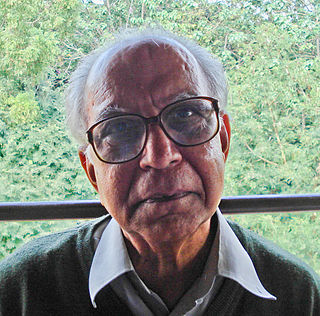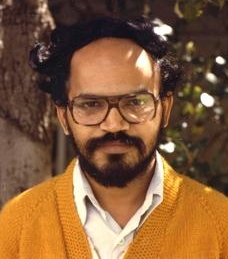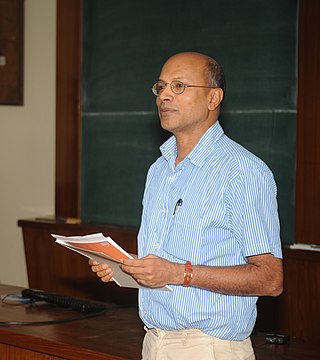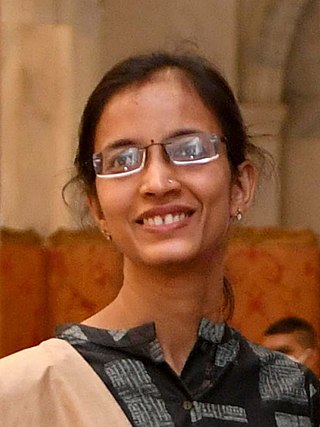
Tata Institute of Fundamental Research (TIFR) is an Indian Research Institute under the Department of Atomic Energy of the Government of India. It is a public deemed university located at Navy Nagar, Colaba in Mumbai. It also has campus in Bangalore, International Centre for Theoretical Sciences (ICTS), and an affiliated campus in Serilingampally near Hyderabad. TIFR conducts research primarily in the natural sciences, the biological sciences and theoretical computer science.

Mudumbai Seshachalu NarasimhanFRS was an Indian mathematician. His focus areas included number theory, algebraic geometry, representation theory, and partial differential equations. He was a pioneer in the study of moduli spaces of holomorphic vector bundles on projective varieties. His work is considered the foundation for Kobayashi–Hitchin correspondence that links differential geometry and algebraic geometry of vector bundles over complex manifolds. He was also known for his collaboration with mathematician C. S. Seshadri, for their proof of the Narasimhan–Seshadri theorem which proved the necessary conditions for stable vector bundles on a Riemann surface.
Srinivasacharya Raghavan was an Indian mathematician who worked in number theory. He was born on 11 April 1934 in Thillaisthanam, Thanjavur, Tamil Nadu. After completing B.A. (Hons) from St. Joseph's College, Tiruchirapalli, he joined TIFR in 1954 as research student, and completed his Ph.D. in 1960 under the supervision of Professors K. Chandrasekharan and K.G. Ramanathan. He was affiliated with TIFR from 1956 until retirement in 1994, and served as Dean of Mathematics Faculty during 1986-89. He played an important role in the development of the TIFR Centre for Applicable Mathematics at Bangalore in its initial years. He also held visiting appointments at the Institute for Advanced Study, Princeton, USA, Sonderforschungsberiech at University of Goettingen, Germany, SPIC Mathematical Institute and taught at the Centre for Advanced Studies in Mathematics at the University of Mumbai for many years.

Shrikrishna Gopalrao Dani is a professor of mathematics at the Centre for Excellence in Basic Sciences, Mumbai who works in the broad area of ergodic theory.
Annamalai Ramanathan was an Indian mathematician in the field of algebraic geometry, who introduced the notion of Frobenius splitting of algebraic varieties jointly with Vikram Bhagvandas Mehta in. The notion of Frobenius splitting led to the solution of many classical problems, in particular a proof of the Demazure character formula and results on the equations defining Schubert varieties in general flag manifolds.

Mahan Maharaj, also known as Mahan Mj and Swami Vidyanathananda, is an Indian mathematician and monk of the Ramakrishna Order. He is currently Professor of Mathematics at the Tata Institute of Fundamental Research in Mumbai. He is a recipient of the 2011 Shanti Swarup Bhatnagar Award in mathematical sciences and the Infosys Prize 2015 for Mathematical Sciences. He is best known for his work in hyperbolic geometry, geometric group theory, low-dimensional topology and complex geometry.

Shekhar C. Mande is Structural and Computational Biologist. He was the Director General of the Council of Scientific and Industrial Research (CSIR), India, and the Secretary of the Department of Scientific and Industrial Research (DSIR), Ministry of Science and Technology. Prior to this, he was the Director of National Centre for Cell Science, Pune.

Dipendra Prasad is an Indian mathematician. He is a professor of mathematics at the Indian Institute of Technology Bombay. He is a number theorist known for his work in the areas of automorphic representations and the Gan–Gross–Prasad conjecture. He is currently the president of Commission for Developing Countries (CDC) of International Mathematical Union (2018–2022) and of Indian Math Society (2021–2022).

Phoolan Prasad is an Indian mathematician who specialised in Partial differential equations, fluid mechanics. He was awarded in 1983 the Shanti Swarup Bhatnagar Prize for Science and Technology, the highest science award in India, in the mathematical sciences category. He is Fellow of all Indian Science Academies: The National Academy of Sciences, India (NASI), Indian Academy of Sciences (IAS) and Indian National Science Academy (INSA).
Trivandrum Ramakrishnan "T. R." Ramadas is an Indian mathematician who specializes in algebraic and differential geometry, and mathematical physics. He was awarded the Shanti Swarup Bhatnagar Prize for Science and Technology in 1998, the highest science award in India, in the mathematical sciences category.
Yamuna Krishnan is a professor at the Department of Chemistry, University of Chicago, where she has worked since August 2014. She was born to P.T. Krishnan and Mini in Parappanangadi, in the Malappuram district of Kerala, India. She was earlier a Reader in National Centre for Biological Sciences, Tata Institute of Fundamental Research, Bangalore, India. Krishnan won the Shanti Swarup Bhatnagar Prize for science and technology, the highest science award in India in the year 2013 in the Chemical Science category.

Institute of Science, Banaras Hindu University (ISc-BHU) is a constituent institute of Banaras Hindu University, Varanasi, India which offers courses in Zoology, Botany, Biochemistry, Computer science, Geography, Mathematics, Physics, Geology, Geophysics, Chemistry, Statistics.
K Sandeep is an Indian mathematician specialising in elliptic partial differential equations. He was awarded the Shanti Swarup Bhatnagar Prize for Science and Technology, the highest science award in India, for the year 2015 in mathematical science category. He is affiliated to the TIFR Centre for Applicable Mathematics, Bangalore.

Neena Gupta is a professor at the Statistics and Mathematics Unit of the Indian Statistical Institute (ISI), Kolkata. Her primary fields of interest are commutative algebra and affine algebraic geometry.
Amalendu Krishna is an Indian mathematician in the Department of Mathematics, Indian Institute of Science (IISc), Bangalore, specializing in algebraic cycles and K-theory. He was awarded the Shanti Swarup Bhatnagar Prize for Science and Technology, India's highest prize for excellence in science, mathematics and technology, in the mathematical sciences category in the year 2016.
Vivek Shripad Borkar is an Indian electrical engineer, mathematician and an Institute chair professor at the Indian Institute of Technology, Mumbai. He is known for introducing analytical paradigm in stochastic optimal control processes and is an elected fellow of all the three major Indian science academies viz. the Indian Academy of Sciences, Indian National Science Academy and the National Academy of Sciences, India. He also holds elected fellowships of The World Academy of Sciences, Institute of Electrical and Electronics Engineers, Indian National Academy of Engineering and the American Mathematical Society. The Council of Scientific and Industrial Research, the apex agency of the Government of India for scientific research, awarded him the Shanti Swarup Bhatnagar Prize for Science and Technology, one of the highest Indian science awards for his contributions to Engineering Sciences in 1992. He received the TWAS Prize of the World Academy of Sciences in 2009.
Virendra Singh is an Indian theoretical physicist and a former C. V. Raman chair professor and director of the Tata Institute of Fundamental Research (TIFR). Known for his research in high energy physics, Singh is an elected fellow of all the three major Indian science academies - Indian National Science Academy, Indian Academy of Sciences and National Academy of Sciences, India as well as The World Academy of Sciences. The Council of Scientific and Industrial Research, the apex agency of the Government of India for scientific research, awarded him the Shanti Swarup Bhatnagar Prize for Science and Technology, one of the highest Indian science awards, for his contributions to Physical Sciences in 1973.
Sudhanshu Shekhar Jha is an Indian condensed matter physicist and a former director of Tata Institute of Fundamental Research. Known for his research in optoelectronics, Jha is an elected fellow of all the three major Indian science academies – Indian National Science Academy, National Academy of Sciences, India and Indian Academy of Sciences – as well as of The World Academy of Sciences and American Physical Society. The Council of Scientific and Industrial Research, the apex agency of the Government of India for scientific research, awarded Jha the Shanti Swarup Bhatnagar Prize for Science and Technology, one of the highest Indian science awards, for his contributions to Physical Sciences in 1979.
Shasanka Mohan Roy is an Indian quantum physicist and a Raja Ramanna fellow of the Department of Atomic Energy at the School of Physical Sciences of Jawaharlal Nehru University. He is also a former chair of the Theoretical Physics Group Committee at Tata Institute of Fundamental Research. Known for developing Exact Integral Equation on pion-pion dynamics, also called Roy's equations, and his work on Bell inequalities, Roy is an elected fellow of all the three major Indian science academies – Indian Academy of Sciences, Indian National Science Academy, and National Academy of Sciences, India – as well as The World Academy of Sciences. The Council of Scientific and Industrial Research, the apex agency of the Government of India for scientific research, awarded Roy the Shanti Swarup Bhatnagar Prize for Science and Technology, one of the highest Indian science awards, for his contributions to Physical Sciences in 1981.
Anish Ghosh is an Indian mathematician specialising in ergodic theory, Lie groups and number theory. He is a Professor in the School of Mathematics of the Tata Institute of Fundamental Research (TIFR), Mumbai. He was awarded the Shanti Swarup Bhatnagar Prize for Science and Technology in Mathematical Sciences in the year 2021. Anish Ghosh is also a part of the INFOSYS-Chandrasekharan Virtual Centre for Random Geometry which is a group of scientists at TIFR Mumbai and ICTS Bengaluru working on topics related to random geometry.









